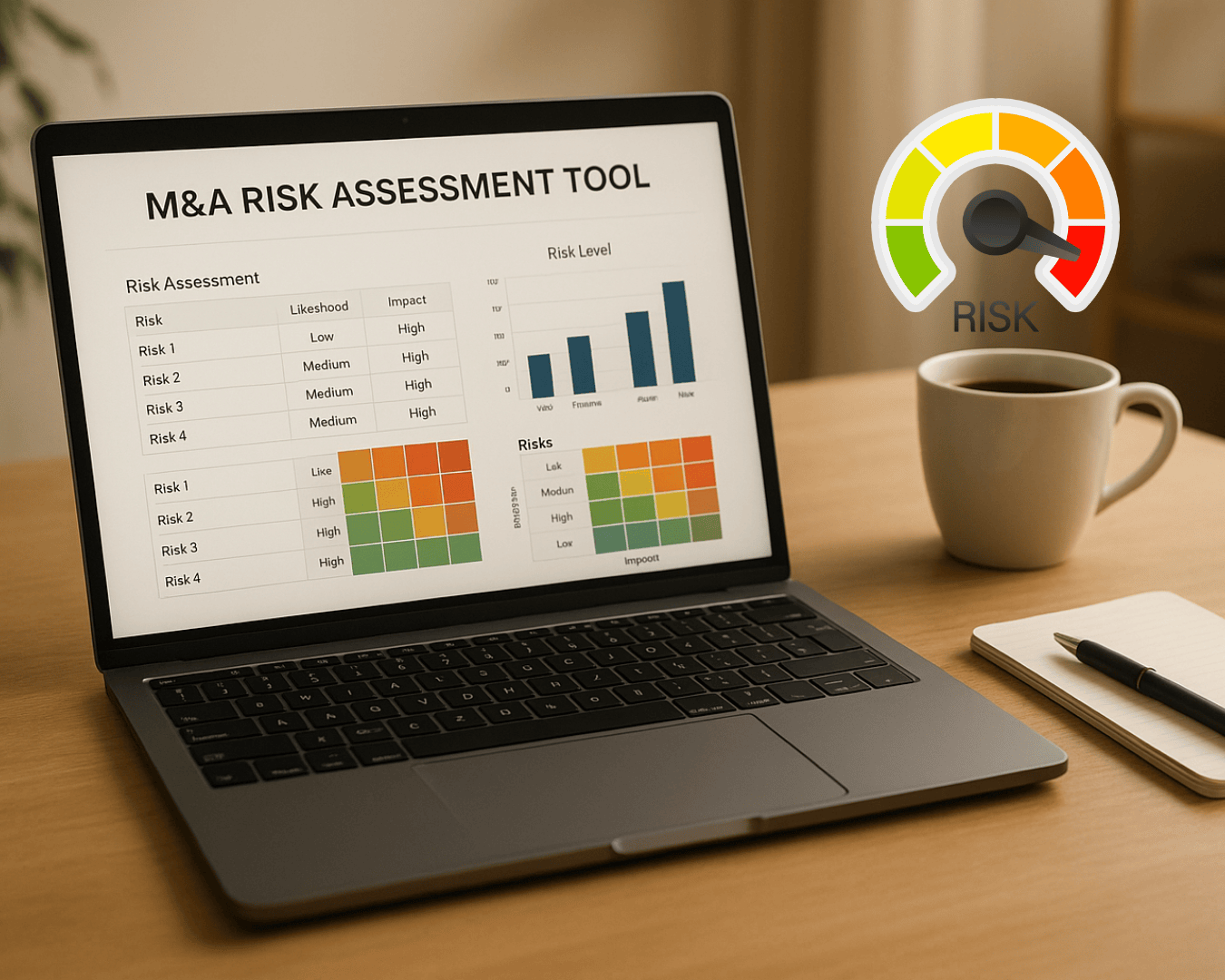Strategic alliances offer small and medium-sized businesses (SMBs) a smart way to grow without the high costs of acquisitions. By partnering with other companies, SMBs can:
- Expand into new markets: Leverage a partner’s customer base, distribution network, or local expertise to reach more customers.
- Share resources: Pool financial, technological, or human resources to achieve goals that might be out of reach individually.
- Reduce risks: Split risks when launching new products or entering unfamiliar markets.
- Boost innovation: Combine expertise to create better products or services faster.
However, alliances come with challenges like potential conflicts, intellectual property risks, or misaligned goals. To succeed, SMBs should carefully choose partners, define clear agreements, and use tools like AI platforms to simplify the process. Platforms like Clearly Acquired help SMBs find partners, manage deals, and secure funding, making the process smoother.
Strategic alliances can open doors to growth, but preparation and the right tools are key to making them work.
What Are Some Examples Of Strategic Alliances? - BusinessGuide360.com
Key Opportunities from Strategic Alliances
Strategic alliances open doors to growth by offering access to new markets, sharing resources, and spreading risks - all while allowing businesses to maintain their independence. These partnerships can be a game-changer for companies looking to expand without taking on the full burden of doing it alone.
New Market Access and Customer Base Growth
One of the biggest perks of strategic alliances is the ability to break into new markets and reach fresh customer segments without the hefty upfront costs often associated with expansion. For small and medium-sized businesses (SMBs), teaming up with established players means tapping into their distribution networks, leveraging their brand reputation, and benefiting from their local market expertise.
Take, for example, a U.S. manufacturer that partners with a well-connected European distributor. Instead of spending years and significant capital building its own international sales network, the manufacturer can immediately access a new customer base. Similarly, a tech startup collaborating with a larger software company might integrate its product into the partner's ecosystem, gaining exposure to a much broader audience.
The real advantage here lies in speed and efficiency. By using a partner's existing market position, SMBs can bypass the lengthy process of market research and relationship-building, accelerating their entry into new territories while keeping costs in check.
But the benefits of strategic alliances don’t stop at market access - they also extend to resource sharing and innovation.
Shared Resources and Innovation
Strategic alliances allow businesses to pool their resources - whether financial, technological, or human - unlocking opportunities that might be out of reach individually. By working together, partners can create synergies that drive innovation and give them a competitive edge.
Imagine two small tech firms collaborating on a new app. They share not only the technical workload and financial risk but also their unique skills and access to cutting-edge technologies. This partnership can result in a faster launch and a stronger product, all while keeping research and development costs down.
Resource sharing in these alliances can take many forms, including:
- Distribution networks and marketing channels: Partners can combine efforts to reach larger audiences more effectively.
- Technology platforms and intellectual property: Joint access to proprietary tools or systems can reduce costs and boost efficiency.
- Specialized personnel: Teams can share expertise to tackle complex challenges together.
For example, in a marketing alliance, companies might share customer data and advertising budgets to create more impactful campaigns. In technology partnerships, joint access to expensive software or hardware can help SMBs achieve goals they couldn’t afford to pursue alone. These shared resources often lead to economies of scale, allowing partners to negotiate better deals with suppliers, run larger projects, and deliver more value to customers.
Collaboration also sparks innovation. When diverse perspectives and skill sets come together, they can generate ideas and solutions that neither partner might have developed on their own. Whether it’s a breakthrough product or a novel business model, the outcomes of these partnerships can be transformative.
While the benefits are clear, it’s important to weigh them against the potential challenges.
Pros and Cons of Strategic Alliances
Strategic alliances come with both opportunities and risks. SMBs need to carefully evaluate these factors to make informed decisions.
| Pros | Cons |
|---|---|
| Access to new markets and customers | Potential loss of control over decisions |
| Shared resources and expertise | Conflicts over goals and management |
| Faster innovation and product development | Increased liability and legal complexity |
| Risk-sharing for major investments | Risk of intellectual property theft |
| Cost savings through economies of scale | Misalignment in business practices or regulations |
| Improved competitive positioning | Unequal contributions or benefits |
The benefits are hard to ignore. New market access can unlock revenue streams, and shared resources make ambitious projects more achievable. Risk-sharing allows SMBs to take on ventures that might otherwise seem too daunting.
However, challenges like loss of control or disagreements over management can derail even the most promising alliances. Intellectual property risks are particularly concerning for companies with proprietary technologies, while mismatched business practices or regulatory hurdles can complicate cross-border partnerships.
To get the most out of a strategic alliance, it’s crucial to conduct thorough partner evaluations, align on goals and values, and establish clear agreements. Open communication and well-defined terms can help prevent many common issues.
Despite the risks, for SMBs looking to grow quickly, enter new markets, or develop innovative solutions, strategic alliances can be a powerful tool. The key is to approach them with clear objectives and a realistic understanding of what it takes to succeed.
Step-by-Step Guide to Forming Strategic Alliances
Establishing a strategic alliance takes careful planning and execution. It's more than just picking a partner - it's about creating a solid foundation for a collaboration that benefits both sides. Here's how small and medium-sized businesses (SMBs) can approach this process effectively.
Finding the Right Partners
Picking the right partner is the cornerstone of any successful strategic alliance. This choice can determine whether the partnership thrives or falters, so it's worth putting in the effort to make a thoughtful decision.
Get your house in order. Before reaching out to potential partners, ensure your business is in good shape. This means organizing your finances, refining your systems, and streamlining your processes. A stable and reliable business is far more appealing to potential partners, and any internal issues can become glaringly obvious in a partnership.
Define your goals and assess compatibility. Be clear about what you want to achieve through the alliance. Is it about entering a new market, co-developing a product, or sharing distribution channels? Once you know your objectives, look for partners who bring what you need - whether that's capital, technology, market knowledge, or specialized expertise.
Align on values. Partnerships work best when the businesses involved share similar values and philosophies. When both sides are on the same page about how they operate and what they prioritize, it's easier to make decisions and resolve conflicts in a way that benefits everyone.
Do your homework. Take the time to research potential partners thoroughly. Look into their social media activity, customer reviews, industry reputation, and financial health. Remember, your partner's reputation will reflect on your business, so conducting due diligence is non-negotiable.
Understand their direction. It's important to know where a potential partner stands today and where they're headed. Are their current state and future plans in sync with your goals? If they're undergoing significant changes, they might not be the best fit for a long-term partnership.
Leverage your network. Use your connections - both online and offline - to get introductions to decision-makers at potential partner organizations. Warm introductions often lead to better outcomes than cold calls, and your existing network can provide useful insights about potential partners.
Once you've identified the right partner, the next step is to structure and negotiate the terms of your alliance agreement.
sbb-itb-a3ef7c1
Challenges and Risk Management in Strategic Alliances
Strategic alliances can offer tremendous opportunities, but they aren't without their hurdles. Even the most promising partnerships can encounter roadblocks. Anticipating these challenges and having a solid risk management plan in place can make the difference between a thriving partnership and one that drains time, money, and energy.
Common Alliance Challenges
Forming and managing alliances comes with its fair share of complications, often catching small and medium-sized businesses (SMBs) unprepared. A major issue is trust - or the lack of it. Without structured communication, misunderstandings can spiral into conflicts. Add to that the friction caused by differing company cultures; for instance, one partner might value quick decision-making while the other prefers a slower, consensus-driven approach. These differences can lead to delays and frustration.
Misaligned goals are another common pitfall. What seems like a shared vision at the outset may reveal discrepancies once the partnership is underway. Power imbalances can also emerge, particularly when one partner brings more resources or market influence to the table.
On an operational level, unclear governance and decision-making processes can make it hard to measure success or address issues early. Strategic risks, such as intellectual property concerns, market cannibalization, or over-reliance on a partner, can jeopardize the core business. Financial disputes - whether over unequal contributions, profit-sharing disagreements, or hidden costs - add further strain. And then there’s the legal minefield: antitrust issues, vague contracts, and regulatory compliance challenges can complicate even the best-laid plans.
Risk Mitigation Methods
The good news? SMBs can take proactive steps to minimize risks and set their alliances up for success. Here’s how:
- Choose partners with aligned values and visions. A strong foundation of shared goals and principles can help weather inevitable challenges.
- Clarify expectations from the start. Clearly define roles, responsibilities, financial commitments, decision-making authority, and performance targets in writing.
- Foster trust through transparency. Open, regular communication about challenges and changes keeps the partnership on track.
- Create adaptable governance structures. Establish decision-making processes that can evolve as needed, with clear escalation procedures and regular reviews to ensure they’re effective.
- Set measurable performance metrics. Agree on key performance indicators (KPIs) that align with the alliance’s objectives and provide early warning signs when adjustments are needed.
- Prepare for the unexpected. Include termination clauses in agreements to outline how assets will be divided and procedures for dissolving the partnership if necessary.
Using a Risk Management Checklist
A structured checklist can help SMBs spot potential problems before they escalate. Here’s what such a checklist might include:
- Partner Evaluation: Assess financial stability, cultural compatibility, strategic alignment, and reputation.
- Legal and Contractual Review: Ensure intellectual property is protected, liability is clearly allocated, and dispute resolution processes and exit strategies are in place. Confidentiality requirements for sensitive information are also key.
- Operational Readiness Assessment: Evaluate communication protocols, decision-making frameworks, performance measurement systems, and resource allocation plans.
- Financial Risk Evaluation: Outline contribution requirements, profit-sharing agreements, cost allocation methods, and plans for managing unexpected expenses.
Regular reviews, clear communication, performance tracking, and defined escalation procedures allow partnerships to adapt as business conditions evolve. These proactive measures help SMBs lay a strong foundation for success, ensuring that they’re ready to tackle challenges head-on and make the most of their alliances.
Using Technology and Advisory Solutions for Alliance Success
Building and managing alliances can be tricky, especially for SMBs. But thanks to technology platforms and advisory services, the process has become far more efficient and less daunting. These solutions take much of the uncertainty and manual effort out of forming partnerships, allowing businesses to focus on the opportunities instead of the hurdles.
Role of Technology in Strategic Alliances
Technology has reshaped how partnerships are formed and managed, simplifying everything from finding the right partner to maintaining a strong relationship. AI tools, for example, can quickly match businesses with potential partners by analyzing factors like industry alignment, financial health, and strategic goals.
Routine tasks, such as deploying NDAs, are handled by automated workflows, saving time and ensuring sensitive information is protected during early discussions. Advanced search features allow businesses to refine their partner searches based on specific criteria, making the selection process more precise.
Verified deal flow systems add an extra layer of confidence, ensuring every potential partner has been thoroughly vetted. Meanwhile, interactive dashboards provide real-time updates on partnership performance, keeping everyone informed and aligned.
Centralized deal management platforms take things a step further by organizing all partnership-related documents, communications, and milestones in one place. This makes it easier to track progress and ensures no critical details slip through the cracks.
By speeding up partner selection and improving risk management, technology has transformed alliance management into a more streamlined and reliable process.
Clearly Acquired: A Complete Solution

Clearly Acquired is a standout example of how technology and advisory services can combine to solve alliance challenges. As a tech-enabled Main Street investment bank, it offers a mix of capital, advisory services, verified deal flow, and proprietary tools to guide businesses through every stage of the partnership process.
The platform’s verified business listings connect SMBs with legitimate, financially stable partners. Its user verification system reduces the risks that often derail alliance discussions, while advanced search tools help businesses find partners based on factors like location, industry, revenue, and strategic goals.
"The Clearly Acquired Platform delivers powerful tools - advanced search, interactive dashboards, and messaging - to streamline acquisitions and empower users with clarity and efficiency."
AI-powered sourcing features uncover both on-market and off-market opportunities, giving SMBs access to partnerships that might otherwise go unnoticed. A secure deal management hub facilitates the sharing of sensitive information and tracks negotiations, creating a safe and organized environment for partnership discussions.
On the financial side, Clearly Acquired offers a variety of funding options, including SBA loans, commercial loans, lines of credit, equipment financing, and equity injections. Loan brokerage and buy-side advisory services simplify financing decisions, ensuring businesses have the resources they need to move forward.
The platform’s impact is clear in real-world examples. In July 2025, Kerianne Los used Clearly Acquired to secure financing in just two weeks, enabling her to expand her facility for a strategic partnership.
To further support SMBs, Clearly Acquired provides educational resources, including a business acquisition course that helps businesses navigate the complexities of alliance negotiations with confidence. For $99 per month, the Verified PLUS plan offers full platform access, webinars, educational content, and financing support.
"Whether you're looking for quality businesses, flexible capital, or expert guidance, we deliver the confidence, speed, and support to help you succeed."
Conclusion: Strategic Alliances as a Growth Driver for SMBs
Strategic alliances stand out as one of the most effective ways for small and medium-sized businesses (SMBs) to grow. These partnerships allow SMBs to tap into new markets, share resources, and collaborate on innovation - opportunities that might otherwise be too costly or challenging to pursue independently. For businesses with limited resources, alliances offer a way to compete with larger players and achieve growth that surpasses traditional methods of expansion.
Take, for example, a manufacturer gaining access to national distribution channels or a tech startup teaming up to co-develop new products. These partnerships highlight the importance of having clear, actionable criteria for selecting the right partners.
The success of any alliance hinges on finding compatible partners, conducting thorough due diligence, and establishing formal agreements. These agreements should clearly outline roles, responsibilities, and methods for resolving potential disputes. The best partnerships are built on mutual trust, shared goals, and well-defined expectations, ensuring both parties benefit equally from the collaboration.
Consistent management is essential for maintaining strong alliances over time. Regular communication and tracking performance help ensure partnerships remain aligned with evolving business goals. Modern tools and advisory solutions have made managing these relationships more efficient. Platforms like Clearly Acquired simplify everything from finding partners to managing deals, offering verified deal flows, AI-driven tools, and advisory services that help SMBs handle the complexities of forming alliances with greater ease and confidence.
To make the most of strategic alliances, SMBs need to combine big-picture strategy with practical action. This involves carefully evaluating potential partners, leveraging technology to streamline processes, and keeping communication open throughout the partnership. Businesses that adopt this balanced approach are better positioned to achieve sustainable growth, not just in terms of immediate financial returns but also by building the skills and market knowledge needed to stay competitive long-term.
For SMBs, strategic alliances provide a clear path to faster growth, broader market access, and greater opportunities for innovation. With thoughtful planning, effective management, and the right tech tools, these partnerships can reshape how small businesses operate and succeed in today’s dynamic business landscape.
FAQs
How can small businesses find the right partners for strategic alliances?
When small businesses seek out partners for strategic alliances, it's crucial to prioritize aligned goals, complementary skills, and mutual values. The ideal partner should share your vision and bring unique resources or expertise that enhance your business operations.
Important considerations include their financial health, history of success, and how well their company culture meshes with yours. Evaluate their potential to support shared growth and ensure they align with your long-term plans. Building partnerships rooted in trust and collaboration is key to achieving meaningful success and fostering new opportunities.
What challenges do small businesses face when forming strategic alliances, and how can they address them?
Small businesses frequently face hurdles such as trust concerns, differences in working styles or values, conflicting goals, and unequal decision-making power when entering strategic partnerships. These challenges can complicate teamwork and potentially jeopardize the success of the alliance.
To navigate these risks, small businesses should prioritize careful research of potential partners, ensuring alignment in values and objectives. It's also crucial to establish clear, shared goals and create comprehensive agreements that define roles and responsibilities upfront. On top of that, adopting risk management practices - like providing employee training and preparing contingency plans - can help protect the partnership and promote smoother collaboration.
How can AI and other technologies make it easier for small businesses to form and manage strategic alliances?
AI and modern technologies are transforming how small businesses form and manage strategic partnerships. Tasks like finding potential partners, conducting due diligence, and maintaining clear communication are now easier, thanks to automation. These tools allow small businesses to quickly identify compatible collaborators, evaluate risks and opportunities, and handle documentation efficiently - saving both time and effort.
With AI handling much of the heavy lifting, small businesses can devote their energy to nurturing meaningful partnerships while simplifying the day-to-day management of those relationships.










.png)







































.png)








































%20Loan%20Application%20Checklist.png)


















